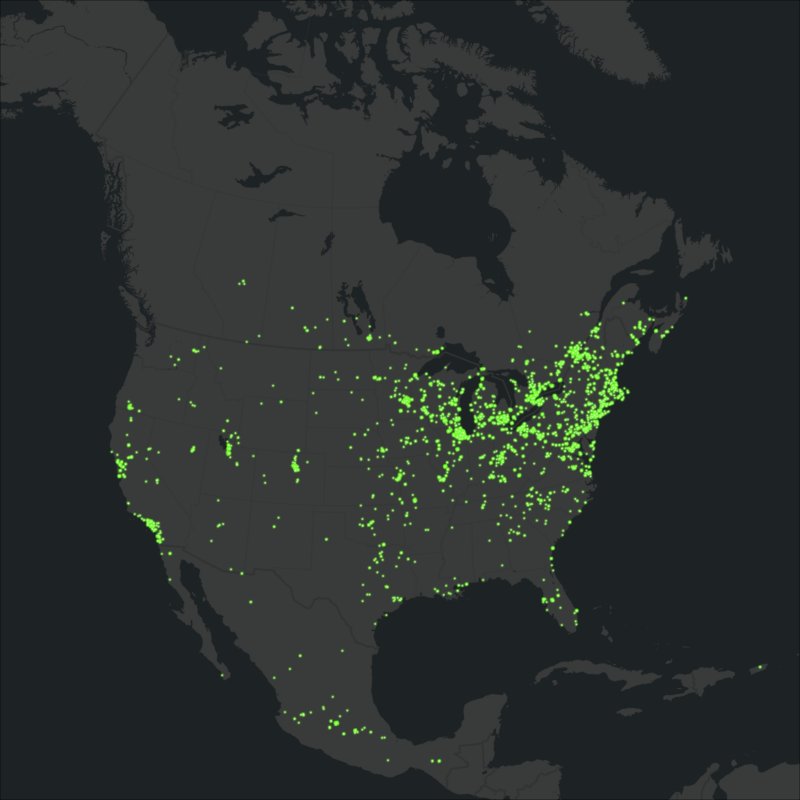Monarch Blitz 2023 Results: Another Successful Year for Community Science in Support of Monarch Butterfly Conservation
Montreal, 11 September 2023—From 28 July to 6 August 2023, the 7th annual International Monarch Monitoring Blitz invited community scientists from across North America to collect data on monarch butterflies and milkweed plants across the monarch butterfly migratory range. This snapshot of the monarch breeding population helps scientists better understand how to protect and conserve one of North America’s most emblematic species.
Over the 10-day period of the 2023 Blitz, 1,789 individuals, across Canada, Mexico and the United States, monitored more than 40,000 milkweed stems and reported seeing more than 13,000 monarchs, all stages combined. Data collected during the Blitz are published in the Trinational Monarch Knowledge Network repository and are available to anyone to consult and download.

Participation in the 2023 International Monarch Monitoring Blitz
“By taking part in the Monarch Blitz, North Americans bridged science and community, nurturing a deeper understanding of monarch butterflies and their summer breeding habitat. This collective effort not only enriched our scientific knowledge but also fostered a trinational network of conservationists, leaving a lasting legacy for the protection of monarchs and a more resilient, interconnected world,” said Isis Howard, Endangered Species Conservation Biologist with the Xerces Society for Invertebrate Conservation.
The Blitz provides a unique opportunity for individuals and organizations to collaborate across international borders to protect this iconic species. This year, we are proud to announce that PROFAUNA of Mexico, through its program Correo Real, joined the list of organizations that help to organize and promote the Blitz across North America.
“The incredible migratory phenomenon of the monarch butterfly reminds us of the importance of transcending political borders and our cultural differences to collaborate in the care of life. What we seek with the Blitz, is to generate scientific information, but also to continue promoting the emotional bond and socio-ecological identity between people and the monarch butterfly,” said Jerónimo Chávez, Project Manager of the Correo Real Program at PROFAUNA.
Additional monarch Blitz partners include the Environment and Climate Change Canada, and the Insectarium | Montréal Space for Life in Canada, the National Commission of Protected Natural Areas (Conanp) in Mexico, and the US Fish and Wildlife Service, Xerces Society for Invertebrate Conservation, Journey North, and the Monarch Joint Venture in the United States.
Participating in an international effort for community science yields many positive outcomes for monarch education, conservation, and science. Greg Mitchell, Wildlife Research Scientist for Environment and Climate Change Canada, shared that his organization “not only participates in the Blitz because of the monitoring potential it provides for assessing annual breeding productivity, but also because of its outreach component. The Blitz provides a gateway for community members to engage with the monarch and by extension, the natural environment.”
Projects like the Blitz have the potential for great impacts beyond monarchs. As Julie Jodoin, Director of Montréal Space for Life, explains, “In placing observation, documentation and understanding of nature at the center of their approach all at the same time, community-science activities like the International Monarch Monitoring Blitz are a bridge between a sense of wonder, knowledge development and the feeling of contributing—three elements necessary for a paradigm shift. They create connections between the population and scientists: they generate productive collaborations. In that sense they are a fantastic tool for protecting the environment and for preserving biodiversity.”
For more information on this year’s results, visit monarchblitz.org or follow #MonarchBlitz on social media. Learn more about the participating community science programs, below:
- Mission Monarch (Canada)
- Journey North (North America)
- NaturaLista (Mexico)
- Correo Real Program (Mexico)
- Monarch Larva Monitoring Project (United States)
- Western Monarch and Milkweed Mapper (Western United States)

The Commission for Environmental Cooperation (CEC) and the Monarch Blitz partner organizations thank everyone who joined the call to support monarch conservation efforts.
About the CEC
The Commission for Environmental Cooperation (CEC) was established in 1994 by the governments of Canada, Mexico and the United States through the North American Agreement on Environmental Cooperation, a parallel environmental agreement to NAFTA. As of 2020, the CEC is recognized and maintained by the Environmental Cooperation Agreement, in parallel with the new Free Trade Agreement of North America. The CEC brings together a wide range of stakeholders, including the general public, Indigenous people, youth, nongovernmental organizations, academia, and the business sector, to seek solutions to protect North America’s shared environment while supporting sustainable development for the benefit of present and future generations
The CEC is governed and funded equally by the Government of Canada through Environment and Climate Change Canada, the Government of the United States of Mexico through the Secretaría de Medio Ambiente y Recursos Naturales, and the Government of the United States of America through the Environmental Protection Agency.